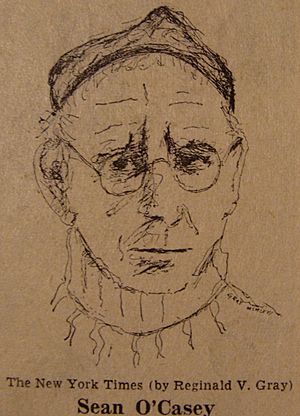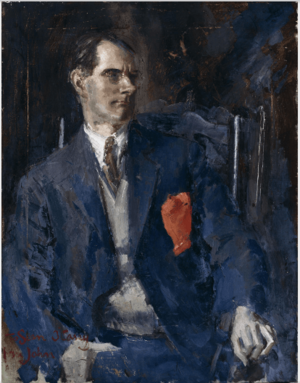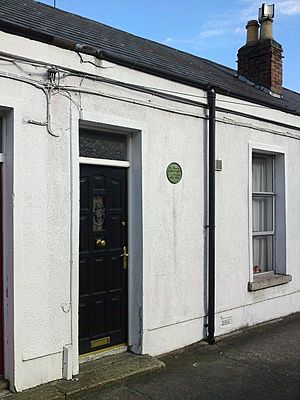Seán O'Casey facts for kids
Quick facts for kids
Seán O'Casey
|
|
|---|---|

O'Casey, c. 1910s
|
|
| Born | John Casey 30 March 1880 Dublin, County Dublin, Ireland |
| Died | 18 September 1964 (aged 84) Torquay, Devon, England |
| Pen name | Seán Ó Cathasaigh |
| Occupation | Dramatist |
| Language | English |
| Spouse |
Eileen Carey Reynolds
(m. 1927) |
| Children | Breon O'Casey, Niall, Shivaun |
| Signature | |
Seán O'Casey (born John Casey; 30 March 1880 – 18 September 1964) was a famous Irish writer who wrote plays and memoirs. He was a socialist, meaning he believed in fairness and equality for everyone. He was the first Irish playwright to write about the lives of working-class people in Dublin.
Contents
Early life
Seán O'Casey was born in Dublin, Ireland, as John Casey. His father worked as a clerk, and his mother was Susan Archer. His family was Protestant. He was baptized in a church and was active in his local church until his mid-20s.
When Seán was only six years old, his father died. This left his mother to care for their thirteen children. The family moved often around north Dublin. As a child, Seán had poor eyesight, which made school difficult. However, he taught himself to read and write by the time he was thirteen.
He left school at fourteen and worked many different jobs. For nine years, he worked for a railway company. He also worked briefly for a newspaper distribution company but was fired for not taking off his cap.
In the early 1890s, Seán and his older brother, Archie, enjoyed putting on plays at home. They performed plays by famous writers like William Shakespeare. Seán even got a small part in a play called The Shaughraun at a local theatre.
Politics and Irish Identity
As Seán grew older, he became very interested in the idea of an independent Ireland. In 1906, he joined the Gaelic League, which promoted Irish culture and language. He even changed his name from John Casey to the Irish version, Seán Ó Cathasaigh.
He also learned to play the Uilleann pipes, a type of Irish bagpipes. He helped start a pipe band and became its secretary. Seán joined the Irish Republican Brotherhood, a secret group working for Irish independence. He also got involved with the Irish Transport and General Workers Union. This union helped unskilled workers in Dublin.
Seán took part in the Dublin lock-out, a big strike in 1913. Because of his involvement, he was "blacklisted," meaning it was hard for him to find steady work for a while.
In 1914, he became the General Secretary of the Irish Citizen Army (ICA). This group was formed to protect workers. However, he resigned from the ICA later that year. He wanted to stop people from being members of both the ICA and another group called the Irish Volunteers, but his idea was rejected.
Seán also wrote satirical songs, making fun of things he disagreed with. One of his first songs, "The Grand Oul' Dame Britannia," was published in a newspaper in 1916.
After the Easter Rising
In 1917, his friend Thomas Ashe died during a hunger strike. This sad event inspired Seán to write more. He wrote two laments, one a poem and one a longer story. He also wrote ballads that were published in 1918. These songs often spoke against Irish people being forced to join the British Army during World War I.
Seán spent the next five years writing plays. In 1918, both his sister and mother passed away. A local club asked him to write a play called The Frost in the Flower. However, the club decided not to perform it because it made fun of some local people. Seán then sent the play to the Abbey Theatre, a famous theatre in Dublin. They also rejected it but told him to keep writing. Seán later made the play longer and called it The Harvest Festival.
Abbey Theatre Success
In 1923, the Abbey Theatre finally accepted and performed Seán O'Casey's play, The Shadow of a Gunman. This was the start of a very important relationship between O'Casey and the Abbey Theatre. It was good for both, but it ended with some sadness later on.
The Shadow of a Gunman shows how political fighting affects the poor people living in Dublin's slums. It is set in Mountjoy Square, where O'Casey lived during the 1916 Easter Rising. This play was followed by two more famous ones: Juno and the Paycock (1924) and The Plough and the Stars (1926).
Juno and the Paycock is about how the Irish Civil War affected poor working-class families. The Plough and the Stars is set in Dublin in 1916 during the Easter Rising. Both plays show the real difficulties and dangers of Irish patriotism. They also show what life was like in crowded tenement buildings, how people sometimes fooled themselves, and how they survived. These plays are sad comedies, where violent deaths make the loud, boastful men seem less important. The strong women, like Juno and Bessie Burgess, show great courage. Juno and the Paycock was even made into a film by Alfred Hitchcock.
The Plough and the Stars caused some controversy at the Abbey Theatre. Some audience members were upset, leading to protests similar to those for another play years earlier. After this, Seán O'Casey quit his job and became a full-time writer.
Even though many people liked the play, some writers criticized it in the newspapers. O'Casey believed they were actually trying to criticize W. B. Yeats, a famous poet and director of the Abbey Theatre, by using O'Casey's play.
Moving to England
While in London for his play Juno and the Paycock, Seán O'Casey met and fell in love with Eileen Carey. They got married in 1927 and lived in London until 1938, when they moved to Totnes.
In 1928, the Abbey Theatre rejected O'Casey's fourth play, The Silver Tassie. This play was about the terrible suffering caused by wars. The Abbey Theatre refused to perform it. It was eventually performed in London but only for a short time. Famous people like George Bernard Shaw and Lady Gregory liked the play.
Denis Johnston, another playwright, thought the Abbey Theatre was right not to stage The Silver Tassie. He said its second act was too modern and difficult for the Abbey Theatre at that time. Even so, O'Casey was upset about this for many years.

O'Casey continued to write many plays. Within the Gates (1934) was a dark story set in a busy city park, like London's Hyde Park. This play was originally planned as a film script for Alfred Hitchcock.
In 1934, O'Casey visited New York City to see a production of Within the Gates. There, he became friends with other famous writers like Eugene O'Neill.
The Star Turns Red (1940) was a political play. It told the story of a trade union leader, Big Red, who was based on O'Casey's friend, James Larkin. The play showed the union taking control of a country despite opposition from a fascist group.
Purple Dust (1943) is a funny play about two rich English businessmen. They buy an old Irish mansion and try to decorate it in an old-fashioned English style. They try to force their ideas on the local Irish community, who have very different ways of life. In the end, a big storm destroys their dream, showing that their ideas don't fit in Ireland.
He also wrote Red Roses for Me (1943). This play showed a new style for O'Casey, using more artistic and symbolic ways to tell a story, with strong socialist messages. It was performed in Dublin and later in London, where O'Casey finally got to see it himself.
Oak Leaves and Lavender (1945) was a play celebrating Britain's bravery during World War II.
These later plays were not as popular as his early ones. After World War II, he wrote Cock-a-Doodle Dandy (1949), which many consider one of his best works. His later plays, like The Bishop's Bonfire (1955) and The Drums of Father Ned (1958), looked closely at everyday life in Ireland.
The Drums of Father Ned was supposed to be performed at the 1958 Dublin Theatre Festival. However, the Catholic Archbishop of Dublin, John Charles McQuaid, did not approve of it. This led to the play being dropped from the festival. In protest, another famous writer, Samuel Beckett, withdrew his own play.
Later life
In 1959, an American composer created a musical version of O'Casey's play Juno and the Paycock, called Juno. However, the musical was not very successful and closed quickly. Although O'Casey, who was 79 at the time, approved of it, he didn't contribute to the production or see it.
Also in 1959, his play Cock-a-Doodle Dandy was successfully performed in London and at a festival in Scotland.
In 1960, O'Casey turned eighty. To celebrate, people wrote studies about his work. A theatre festival in London in 1962, called the "O'Casey Festival," led to more of his plays being performed, especially in Britain and Germany. In his later years, O'Casey also focused on writing his six-volume autobiography.
Seán O'Casey passed away from a heart attack on 18 September 1964, at the age of 84, in Torquay, England. He was cremated.
In 1965, his autobiography was made into a film about his life called Young Cassidy. The film starred Rod Taylor as O'Casey and other famous actors.
Personal life
Seán O'Casey was married to an Irish actress named Eileen Carey Reynolds (1903–1995). They were married from 1927 until his death. They had three children: two sons, Breon and Níall (who sadly died in 1957 from leukaemia), and a daughter, Shivaun.
Archival collection
Many of Seán O'Casey's important papers, including letters he wrote, are kept in libraries and universities around the world. These include the New York Public Library, Cornell University Library, and the National Library of Ireland.
Works
- Lament for Thomas Ashe (1917), as Seán Ó Cathasaigh
- The Story of Thomas Ashe (1917), as Seán Ó Cathasaigh
- Songs of the Wren (1918), as Seán Ó Cathasaigh
- More Wren Songs (1918), as Seán Ó Cathasaigh
- The Harvest Festival (1918)
- The Story of the Irish Citizen Army (1919), as Seán Ó Cathasaigh
- The Shadow of a Gunman (1923)
- Kathleen Listens In (1923)
- Juno and the Paycock (1924)
- Nannie's Night Out (1924)
- The Plough and the Stars (1926)
- The Silver Tassie (1927)
- Within the Gates (1934)
- The End of the Beginning (1937)
- A Pound on Demand (1939)
- The Star Turns Red (1940)
- Red Roses for Me (1942)
- Purple Dust (1940/1945)
- Oak Leaves and Lavender (1946)
- Cock-a-Doodle Dandy (1949)
- Hall of Healing (1951)
- Bedtime Story (1951)
- Time to Go (1951)
- The Wild Goose (1952)
- The Bishop's Bonfire: A Sad Play within the Tune of a Polka (1955)
- Mirror in My House (two volumes, 1956, reissued as Autobiographies, 1963 and since; combining the six books of memoirs listed next)
- I Knock at the Door (1939)
- Pictures in the Hallway (1942)
- Drums Under the Window (1945)
- Inishfallen, Fare Thee Well (1949)
- Rose and Crown (1952)
- Sunset and Evening Star (1954)
- The Drums of Father Ned (written 1957, staged 1959)
- Behind the Green Curtains (1961)
- Figuro in the Night (1961)
- The Moon Shines on Kylenamoe (1961)
- Niall: A Lament (1991)
Awards and recognition
- (1926) – Hawthornden Prize for Juno and the Paycock
- (1949) – Newspaper Guild of New York's "Page One Award" for his autobiographies
- Order of the British Empire (declined)
- (1960) – Durham University Honorary Degree (declined)
- (1960) – University of Exeter Honorary Degree (declined)
- (1961) – Trinity College, Dublin Honorary Degree (declined)
Legacy
In Dublin, a foot bridge over the Liffey is named after him, honoring his memory.
See also
 In Spanish: Sean O'Casey para niños
In Spanish: Sean O'Casey para niños




